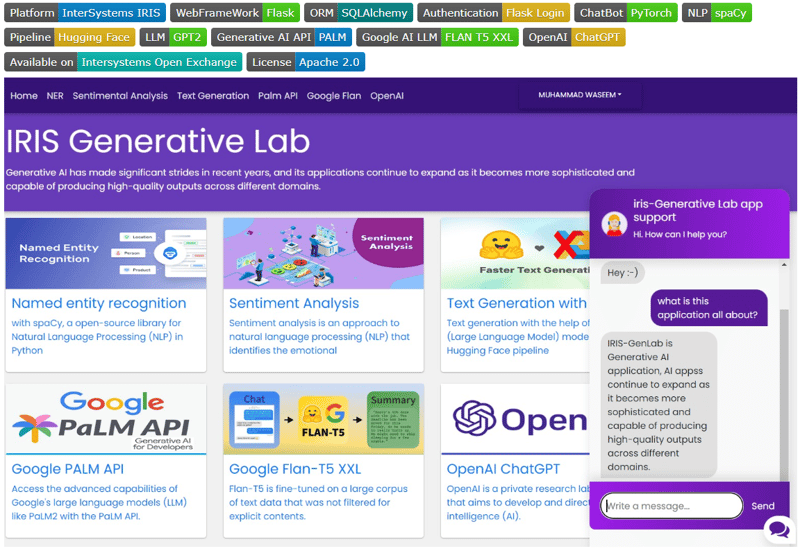Hi Community
In this article, I will introduce my application IRIS-GenLab.
IRIS-GenLab is a generative AI Application that leverages the functionality of Flask web framework, SQLALchemy ORM, and InterSystems IRIS to demonstrate Machine Learning, LLM, NLP, Generative AI API, Google AI LLM, Flan-T5-XXL model, Flask Login and OpenAI ChatGPT use cases.
Application Features
User registration and authentication
Chatbot functionality with the help of Torch (python machine learning library)
Named entity recognition (NER), natural language processing (NLP) method for text information extraction
Sentiment analysis, NLP approch that identifies the emotional tone of the message
HuggingFace Text generation with the help of GPT2 LLM (Large Language Model) model and Hugging Face pipeline
Google PALM API, to access the advanced capabilities of Google’s large language models (LLM) like PaLM2
Google Flan-T5 XXL, a fine-tuned on a large corpus of text data that was not filtered for explicit contents.
OpenAI is a private research laboratory that aims to develop and direct artificial intelligence (AI)
Application Flow
Python app.py file import
#import genlab application
from genlab import create_app
from genlab.myconfig import *
from flaskext.markdown import Markdown
if __name__ == “__main__”:
# get db info from config file
database_uri = f’iris://{DB_USER}:{DB_PASS}@{DB_URL}:{DB_PORT}/{DB_NAMESPACE}‘
# Invokes create_app function
app = create_app(database_uri)
Markdown(app)
#Run flask application on 4040 port
app.run(‘0.0.0.0’, port=“4040”, debug=False)
The above code invokes create_app() function and then runs the application on port 4040
create_app() function is defined in __init__.py file, which create/modify database and initilize views
from flask import Flask
from flask_sqlalchemy import SQLAlchemy
from flask_login import LoginManager
from .myconfig import *
#init SQLAlChemy reference
db = SQLAlchemy()
def create_app(database_uri):
app = Flask(__name__)
app.config[‘SECRET_KEY’] = “iris-genlab”
# Getting DB parameters from myconfig.py file
app.config[‘SQLALCHEMY_DATABASE_URI’] = database_uri
app.app_context().push()
from .views import views
from .auth import auth
from .models import User
#register blueprints
app.register_blueprint(views, url_prefix=“/”)
app.register_blueprint(auth, url_prefix=“/”)
#init datbase
db.init_app(app)
with app.app_context():
db.create_all()
# Assign Login View
login_manager = LoginManager()
login_manager.login_view = “auth.login”
login_manager.init_app(app)
def load_user(id):
return User.query.get(int(id))
return app
The above code creates the database by invoking SQLAlchemy create_all() function which will create user table based on structure defined in the models.py file
from . import db
from flask_login import UserMixin
from sqlalchemy.sql import func
#User table
class User(db.Model, UserMixin):
id = db.Column(db.Integer, primary_key=True)
email = db.Column(db.String(150), unique=True)
username = db.Column(db.String(150), unique=True)
password = db.Column(db.String(150))
date_created = db.Column(db.DateTime(timezone=True), default=func.now())
def __repr__(self):
return f’{self.username}‘
Named entity recognition (NER)
Named entity recognition with spaCy, a open-source library for Natural Language Processing (NLP) in Python
Navigate to to http://localhost:4040/ner, enter text and click on submit button to view the results
Above URL invoces ner() methon from views.py file
from flask import Blueprint, render_template, request
from flask_login import login_required, current_user
from spacy import displacy
import spacy
HTML_WRAPPER = “””<div style=”overflow-x: auto; border: 1px solid #e6e9ef; border-radius: 0.25rem; padding: 1rem”>{}</div>”””
views = Blueprint(“views”, __name__)
#Named Entitiy Recognition
def ner():
if request.method == ‘POST’:
raw_text = request.form[‘rawtext’]
result = ”
if len(raw_text.strip()) > 0:
# Load English tokenizer, tagger, parser and NER
nlp = spacy.load(‘en_core_web_sm’)
docx = nlp(raw_text)
html = displacy.render(docx, style=“ent”)
html = html.replace(“nn”, “n”)
result = HTML_WRAPPER.format(html)
return render_template(‘ner.html’, user=current_user, result=result,rawtext = raw_text, pst=True )
return render_template(‘ner.html’, user=current_user, pst=False)
Below is the ner.html template file which inhertied from base.html (Change every “[” or “]” below on “{” and “}”)
[% extends”base.html” %] [% block title %]Home[% endblock %]
[% block head %]
<h2 class=“display-4”>Named entity recognition</h2>
<p>with spaCy, a open-source library for Natural Language Processing (NLP) in Python</p>
[% endblock %]
[% block content %]
<form method=“POST”>
<textarea rows=“7” required=“true” name=“rawtext” class=“form-control txtarea-main”>
[[ rawtext ]]
</textarea>
<button type=“submit” class=“btn btn-info”><i class=“fa fa-database”></i> Submit</button>
<a class=“btn btn-primary waves-effect” href=“/” role=“button”> <i class=“fa fa-eraser”></i> Refresh</a>
</form>
[% if pst %]
[% filter markdown %]
[% endfilter %]
<hr/>
<div class=“card shadow-sm” id=“custom_card2”>
<h4>Result</h4>
<p>[[ result|markdown ]]</p>
</div>
[% endif %]
[% endblock %]
Application Database
SQLALchemy will create below tables:
user: To store User information
To view table details, navigate to http://localhost:52775/csp/sys/exp/%25CSP.UI.Portal.SQL.Home.zen?$NAMESPACE=USER#
For more details please visit IRIS-GenLab open exchange application page
Thanks




